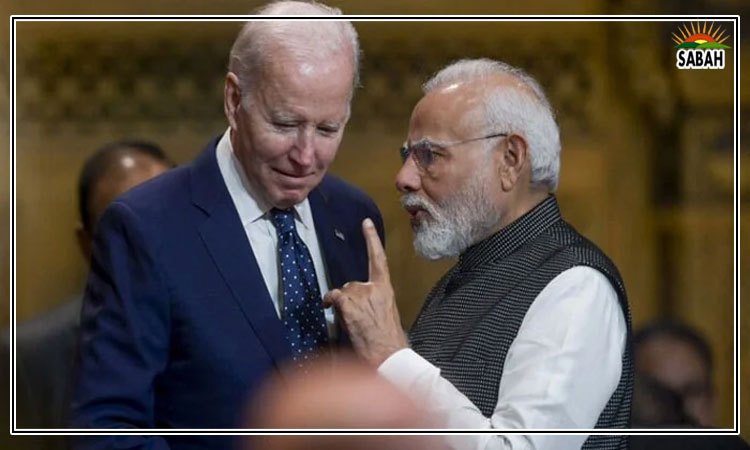Beyond the India gambit…Shaukat Ahmed
China, with its rapid economic growth and expanding influence, has emerged as the primary focus of American foreign policy in recent years. Consequently, Washington has increasingly sought a strategic partnership with India to counterbalance Beijings rising power in Asia.
While this approach is strategically sound in many respects, it may overlook a more nuanced and potentially complementary strategy: leveraging Pakistans unique position as both an American ally and a close partner of China.
The US-India partnership is grounded in logical assumptions Indias democratic ethos, economic potential, and strategic location align with American interests in countering China. However, this perspective may oversimplify the complex realities of South Asian geopolitics. Although Indias economic and military capacities are growing, they still lag behind Chinas. This gap is not merely quantitative but qualitative, with Chinas technological advancements and strategic investments widening the chasm year by year. This disparity profoundly limits New Delhis ability to serve as the sole counterbalance to Beijings influence.
This strategy also fails to account for a critical historical phenomenon: the Economic Interdependence Paradox. While US alignment may currently serve Indias interests, as Indias economy grows, it may become more intertwined with Chinas economy, not less. This increasing economic interdependence could limit Indias willingness to act as a strategic counterweight to China, potentially undermining US expectations and strategy in the region.
Moreover, the US might be overestimating the appeal and effectiveness of its cultural soft power in India, while underestimating the rise of right-wing nationalism and fascist tendencies. India’s strong cultural identity and growing Hindu nationalist movement could not only limit the effectiveness of American soft power but also create ideological friction that complicates the partnership.
The current Indian government’s policies, which some critics characterize as increasingly authoritarian and exclusionary, particularly towards religious minorities, stand in stark contrast to the democratic values the US claims to promote. By overlooking or downplaying these developments in favour of geopolitical expediency, the US risks aligning itself with an increasingly illiberal regime.
Deeper engagement with Pakistan is crucial for maintaining a balanced approach to South Asia and avoiding the pitfalls of an overly India-centric strategy. Therefore, the potential of Pakistan as a stabilizing force in the region deserves greater consideration. Additionally, it helps avert the risk of alienating Pakistan, which could otherwise be propelled further into Chinas sphere of influence.
This could have several negative consequences with far-reaching implications for US interests as well as regional stability. Reduced American influence in Pakistan would significantly limit Americas ability to shape regional outcomes and advance its strategic objectives. This diminished role could create a vacuum that China would likely fill, potentially leading to a more assertive Chinese presence in South Asia. Most importantly, such a shift could intensify regional polarisation, further destabilizing an already fragile geopolitical landscape.
Overemphasizing India in US strategy therefore risks exacerbating regional tensions, particularly given Indias strained relationships with its neighbours, especially Pakistan. This approach may inadvertently undermine regional stability and contradict broader US goals. By focusing too heavily on India, the US might actually accelerate the transition to a multipolar world order, giving Beijing more room to manoeuvre and expand its influence in other regions.
Pakistan, often relegated to the periphery of US strategic calculus, offers a unique and underutilised advantage that could be far more effective in addressing American concerns about China. Despite challenges in US-Pakistan relations, such as Pakistan’s perceived support for non-state actors and its internal political instability, Islamabad remains a crucial ally. This relationship, forged during the cold war and reinforced through counterterrorism cooperation, provides a solid foundation for deeper engagement and strategic collaboration.
Pakistans geopolitical significance extends beyond its bilateral ties. As a nuclear-armed nation at the crossroads of the Middle East, Central Asia, and South Asia, Pakistan is integral to regional stability. Its location along the Arabian Sea provides strategic access to key maritime routes and proximity to the Strait of Hormuz, through which a significant portion of the worlds oil supply passes. Pakistans influence in Afghanistan and its role in the broader Islamic world are also crucial in managing regional stability and counterterrorism efforts.
Pakistans close relationship with China grounded in strategic, economic, and military cooperation, including the China-Pakistan Economic Corridor offers it unique insight into Beijings interests. These close ties position Pakistan as a distinctive diplomatic bridge between Washington and Beijing. By leveraging this relationship, the US could foster dialogue and understanding with China, potentially mitigating the adversarial dynamics currently at play.
However, this strategy is not without risks. Critics point out that Pakistans internal challenges, such as political unpredictability and economic fragility, make Islamabad a potentially unreliable partner. To mitigate these risks, the USs strategies must be flexible, incorporating contingency plans that account for the potential volatility of Pakistans domestic situation, which could disrupt agreements or hinder the effective implementation of development projects.
Washingtons engagement with Islamabad should prioritize supporting Pakistans economic stability and development. This could involve targeted investments in infrastructure, education, and industry, as well as fostering trade relationships that strengthen Pakistans economy and contribute to a more stable partnership.
Furthermore, a more balanced US approach to South Asia should not sideline India. Instead, Washington could adopt a dual strategy that deepens its partnership with both India and Pakistan, recognizing that both nations are critical to regional stability. Engaging both countries could help reduce tensions between them and encourage a more cooperative regional dynamic.
To implement this strategy, the US could pursue specific policy actions such as bilateral economic initiatives. The US could establish bilateral trade agreements with Pakistan focused on industries that can provide mutual benefits, such as technology and renewable energy.
Second, regional diplomatic efforts. Trilateral talks involving the US, India, and Pakistan could be initiated to address regional security concerns and promote economic cooperation.
Third, counterterrorism support. The US could continue and expand counterterrorism cooperation with Pakistan while encouraging reforms that address the root causes of extremism within its borders.
And, fourth, development assistance. US development assistance to Pakistan could be increased, particularly in education and infrastructure, to foster economic stability and reduce political instability.
Imagine a Pakistan with a robust economy, thriving industries, and a burgeoning middle class. Such a nation would naturally gravitate towards policies that preserve its hard-won gains, creating a bulwark against extremism and reducing the allure of conflict. By supporting initiatives that enhance Pakistans economic landscape, the US can help sculpt this vision into reality.
Despite the formidable challenges facing Pakistans economic transformation, the potential benefits of a more robust economy make this vision not only worth pursuing but crucial for regional stability and prosperity. A thriving economy, characterized by increased job opportunities and improved living standards, could serve as a powerful counterforce to extremist ideologies by offering viable alternatives and hope for a better future. As more Pakistanis ascend to the middle class, they would naturally develop a vested interest in maintaining stability and opposing disruptive forces, creating a self-reinforcing cycle of growth and security.
Pakistans large youth population represents a significant demographic dividend that, if properly harnessed, could become a driving force for economic development and innovation, thereby not only bolstering the countrys economy but also fostering a generation more resistant to extremist influences and more inclined towards international cooperation and peace.
However, this strategy requires a nuanced understanding of regional dynamics and a willingness to engage in complex, multipolar diplomacy. It also necessitates realistic expectations, as Pakistans transformation into a stable, prosperous nation is a long-term goal that will demand sustained effort and patience from both Islamabad and Washington.
The imperative for cooperation over confrontation has never been more acute. In an era defined by global challenges such as climate change, pandemic preparedness, and economic instability, the zero-sum mentality of great power competition is increasingly outdated.
By strategically utilizing Pakistan’s distinctive position and adopting a more balanced approach in South Asia, the US could pioneer a new model of trilateral engagement that addresses these global threats through collaborative problem-solving rather than adversarial posturing.
Ultimately, recognizing Pakistan as a vital player on the regional chessboard is not just about countering China or balancing India, but about fostering a stable, peaceful, and prosperous South Asia, which aligns with long-term US interests.
The writer is a Pakistani entrepreneur based in the United States and the United Kingdom. He tweets @viewpointsar and can be reached at: sar@icloud.com
Courtesy The News












